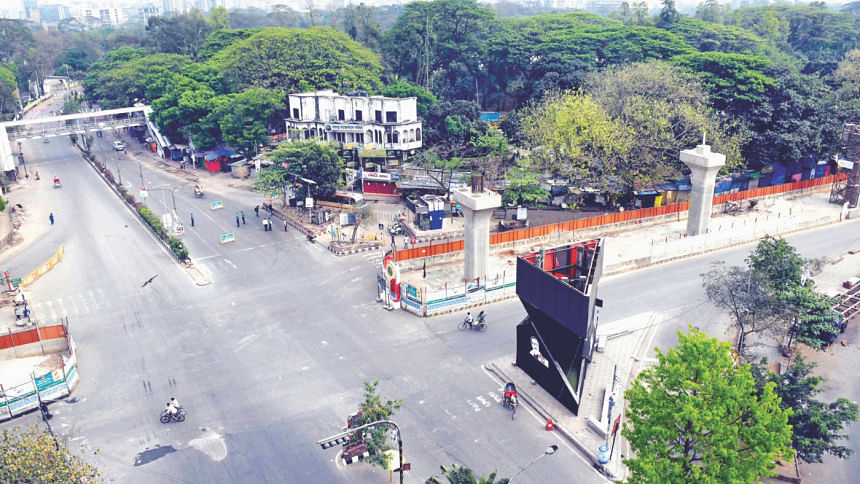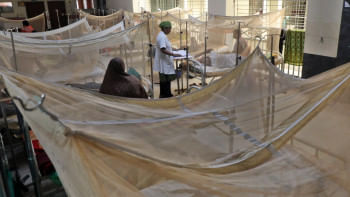We paused the economy to save lives. But how do we press play again?

The historical novelty of the coronavirus shock has unravelled as the lockdown continues. Bangladesh's economic expansion is projected to face a drastic brake.
Such brakes are expected all over the world more or less. Germany and France are already in recession. The American economy is expected to shrink as much as during the Great Depression but much quicker.
There has never been a crash landing like this before.
The immense human distresses defy calculation. Yet the point of attempting economic calculations, as done in the World Bank's just-released South Asia Economic Focus, is to gauge the likely impact of the coronavirus-induced disruptions and its propagation through the economy.
The fall in growth is the result of a deliberate policy choice made unavoidable by the killer pandemic.
We now face a protracted period in which falling consumption, exports and investment drive further contraction.
Some 93 per cent of the low-income households reported on average 75 per cent loss of income, according to the Brac perception survey carried out between March 31 to April 5.
The longer the lockdown, the deeper the scarring to the economy.
Given the risk of second- and third-wave outbreaks, no one has any idea how far and how fast the resumption of normal life can safely proceed.
We still seem to be on the exponentially rising part of the spread curve, as evident from recent official data on infections.
The correlation between the number of positive cases and the number of tests done is 0.96 (based on data covering the last 14 days).
The good news is that the cumulative number of tests has increased exponentially in recent weeks. The bad news is that so has the number of infected cases.
Bangladesh has the lowest number of tests per 1 million population amongst South Asian, East Asian and Southeast Asian countries.
Countries that have lower tests per million population than Bangladesh are Papua New Guinea, Mauritania, Mozambique, Haiti, Myanmar, Nigeria, Ethiopia and Zimbabwe.
Bangladesh's testing coverage looks even lower when compared across countries vis-à-vis their population densities.
More relevant metrics to gauge the state of the virus spread may be data on community-level proxy indicators such as respiratory-related hospitalisation and COVID-19 suspect deaths.
These can help identify infection hotspots where the limited testing capacity may be focused.
At the current rate, mass testing is an unlikely possibility.
The World Bank has just produced a new research and policy brief, titled 'How Two Tests Can Help Contain COVID-19 and Revive the Economy', where it suggests that two tests "can help governments shorten and soften economically costly suppression measures while still containing the novel coronavirus pandemic".
The first test facilitates the identification of infected persons, the tracing of their contacts and isolation.
The second antibody test can help assess the extent of immunity in the general population or subgroups, to finetune social isolation and manage health care resources.
The first test is generally available but needs to be processed in adequately equipped laboratories with trained staff. The second test is easy to perform and can be processed quickly on the spot. But at this stage, its reliability is not conclusively established.
It is available only on a limited scale in a few countries. The estimated economic benefits of the tests are likely to far outweigh the cost, as this research shows.
The international community must help countries develop the capacity to process the first test and procure the second when it is proven to work.
The above would be ideal, but not realistic to expect in low middle-income countries such as Bangladesh to the extent possible in high-income countries.
There are radical uncertainties in the current situation. Many unknown, unknowns. However, we know for sure the following:
First, the virus spread risk is currently extremely high. Although we may not be able to scale up testing, tracing and isolating like the rich countries, we have to massively scale up from where we are.
Our dotted line on the virus spread diagram -- the capacity of our health care system to help everyone who is very sick -- is very low.
We will have to deploy a lot more resources at elevated levels of efficiency to save lives and contain the spread.
We need to invest in facilities and people to raise the dotted line. Providing the frontline responders -- the doctors, nurses, pharmacists, technicians, the military and the police -- safety gears, equipment, training and social protection is the topmost priority.
It is not a challenge either the public or the private sector can handle by going it alone.
Bringing the public health workers under health and life insurance coverage and adding honorariums to their salaries are right moves.
They all need to be provided more testing kits, labs, medical supplies, hospital beds and ventilators all over the country to test and treat quickly as many as possible to maximise the benefits from the lockdown.
Social distancing remains the only large-scale measure available to prevent the infection spread.
We need to learn from China and Singapore on how to ensure even enforcement. We need to learn from South Korea, Kerala and Sweden on how to ensure consistency in the interpretation of social distancing messages.
There is still a lack of awareness among many sections of the population. Livelihood disruptions make it impossible for many poor to stay home.
Customising social distancing and hygiene measures in densely-settled urban slums remains a daunting challenge that no country has yet found a way to come to grips with.
Second, we will have to make a call in May or June on how to open up.
Our troubles will deepen geometrically if we do not massively scale up testing before reaching this point.
Yet, the decision to relax suppression of the economy will need to be made without the benefit of sufficient tests.
It's not just the health of the population but also the health of the prevailing social order that is at risk.
Unlike the sudden stop, the reopening will not be a sudden start with a big bang. It will have to be selective, gradual and methodical. Given the resource constraints, the testing strategy might need to be prioritized to facilitate reopening.
There is now a lot of discussion on differentiated reopening. Starting with "essentials" (food, clothing, housing) and non-essentials (sports, theatres and malls), difficult choices will need to be made about what activities to reopen where and who should be allowed back to work.
Spread risk mapping of areas (hotspots) and activities within a particular essential sector (rice in agriculture) will allow science to shape the choices.
High-risk activity in high-risk areas can be categorised as red; low-risk activity in low-risk areas as green, while the other two -- high-risk activity in low-risk areas and low-risk activity in high-risk areas -- can be categorised as brown.
The green category can be opened in the first phase provided the red category is fully contained and the brown categories are locked.
While the green zones reopen, aggressive testing and tracing in the brown zones to isolate and treat the infected will be needed to pave the way for their reopening as efforts to test, trace, isolate and treat in the red continue.
In the last phase, the lockdown ends completely when the red eventually becomes green. Until a vaccine is available, all the reopening will remain subject to the feasibility of social distancing.
Factories and markets may be allowed to operate at different times.
Let's say, some in the first half and others in the second half of the month. There has to be some coordination between the two because one without the other may not do much economic good.
Should the factories stagger shift with, say, no more than 50 per cent capacity utilisation in each shift to maintain 6 feet physical distancing between workers?
Should the restaurants have fewer tables? Should there be restrictions on the number of passengers per transport vehicle? Should shops be subject to factory type staggering and social distancing requirements? Will all these be enforceable?
Social distancing may be easier to practice in some sectors, say pharmaceuticals, garments, banks and departmental stores than others such as land and water transport or retail and wholesale trades.
India has just announced Lockdown 2.0. It allows rural industries; agriculture, fisheries and horticultural activities; cargo trucking; construction activities where workers can live on site; public workfare programme; and e-commerce and courier services in non-hotspot areas to operate. All other activities remain suspended.
How this works may bring important lessons for many densely populated low and lower middle-income countries.
Differentiation by demographics can help prevent the explosion of spread risk due to reopening.
Should the young with no pre-existing conditions return first while the high-risk groups stay home until they are all tested? Should females be preferred to males since they appear to be better fighters of COVID19?
According to the World Health Organisation's April 13 Situation Report #7, male represent 70 per cent of the reported cases in Bangladesh.
Assumptions about the risk profile of different demographic groups will have to be verified more rigorously from our own data.
It is possible many young and females are as vulnerable as the elderlies because a vast number of them are poor living in dense communities in polluted areas.
The immune systems of low-income youths and females may be as weak, if not weaker, than high-income elderlies and females.
Compilation and analysis of our own data by competent researchers have to be rapid in real-time so that it can feed policy choices.
An online real-time national data bank on COVID-19 symptomatic, infections, recovery and death is critical for dispassionately updating evidence from data points added every day.
Even assuming social assistance to the poor and the vulnerable, lockdown will be subject to diminishing effectiveness over time.
Absent social assistance, the compulsion to reopen is even more obligatory.
A corollary is the extent of production and distribution chain coordination needed to make the reopening economically meaningful. The real choice is between ways of reopening.
The implementation of a differentiated approach is not remotely as simple as the above may sound.
The war against such a wickedly powerful and invisible enemy whose vulnerabilities are yet to be discovered cannot be easy. It is unprecedented.
How do you keep the green zones green and prevent the browns from turning red?
Blocks of areas and people may need to be physically and socially separated to prevent the inter-zonal spread of the virus. Workers in green zones will need lodging, for instance.
The immune systems of the poor are weaker and yet their need to return to work is the most pressing! The green, red and brown are neither neatly divisible nor static over time.
The design of the strategy must be based on epidemiological dynamics, economic incentives and the ability to govern.
Cliché in the rich countries is "we need an all of the government approach". The cliché in low capacity countries such as Bangladesh ought to be "we need an all of society approach" to tap ideas, mobilise resources, and push back unwarranted political and business pressure.
Some chaos during the transition is probably fait accompli in any context, ours' in particular, given the inertia in our social decision-making processes, and the time it takes to adapt to new behavioural norms at work.
Policymakers can only attempt to make the transition more orderly, the adaptation quicker and unlock aggregate demand more than otherwise would be the case.
The writer is an economist

 For all latest news, follow The Daily Star's Google News channel.
For all latest news, follow The Daily Star's Google News channel. 



Comments